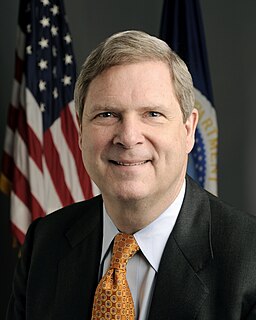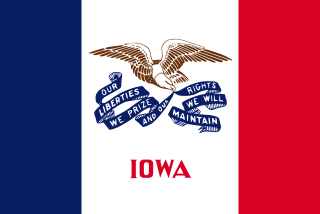
The 1986 United States Senate elections was an election for the United States Senate in the middle of Ronald Reagan's second presidential term. The Republicans had to defend an unusually large number of freshman Senate incumbents who had been elected on President Ronald Reagan's coattails in 1980. Democrats won a net of eight seats, defeating seven freshman incumbents and regaining control of the Senate for the first time since January 1981. The party not controlling the presidency gained seats, as usually occurs in mid-term elections.

The Iowa gubernatorial election of 2006 took place November 7, 2006. The incumbent governor, Tom Vilsack, a Democrat, had served two terms and decided not to seek a third term. In the election, Chet Culver defeated Jim Nussle to win the governorship, by a margin of 54.4 percent to 44.1 percent. As of 2019, this is the last time a Democrat has won the governorship of Iowa.
The Iowa Democratic Party (IDP) is the affiliate of the United States Democratic Party in the state of Iowa.

United States gubernatorial elections were held on November 2, 2010 in 37 states and two territories. As in most midterm elections, the party controlling the White House lost ground. Democrats did take five governorships from the Republicans, and Republicans took 11 governorships from the Democrats. An independent won one governorship previously held by a Republican. A Republican won one governorship previously held by an independent. Republicans held a majority of governorships for the first time since before the 2006 elections. One state, Louisiana, had no election for governor, but did feature a special election for lieutenant governor.

The 2010 Illinois gubernatorial election took place on November 2, 2010. Incumbent Democratic Governor Pat Quinn sought and was elected to a full term in office. Quinn was elected as the Democratic nominee, the Illinois Green Party nominee was attorney and 2006 nominee Rich Whitney, the Republican nominee was State Senator Bill Brady, the Libertarian Party nominee was Lex Green, and Scott Lee Cohen ran as an independent. Governor Quinn won election to a full term in a very close race, beating Senator Brady by only about 32,000 votes, despite Brady winning in 98 of 102 Illinois counties.

The Iowa gubernatorial election of 2010 was held on Tuesday, November 2, 2010 to elect the governor and lieutenant governor, to serve a four-year term beginning on January 14, 2011. In Iowa, the governor and lieutenant governor are elected on the same ballot.

The Iowa gubernatorial election of 2002 took place November 5, 2002. Incumbent Democratic Governor of Iowa Tom Vilsack sought re-election to a second term as governor. Governor Vilsack won his party's nomination uncontested, while Doug Gross, an advisor to former Governor Terry Branstad, narrowly won the Republican Party's primary in a crowded and competitive election. In the general election, Vilsack was able to improve ever so slightly on his margin of victory four years earlier to win what would be his second and final term as governor.

The Iowa gubernatorial election of 1994 took place November 8, 1994. Incumbent Republican Governor of Iowa Terry Branstad ran for re-election to a fourth term as governor. Branstad narrowly defeated a tough challenger in his primary election, emerging victorious by less than 12,000 votes. On the Democratic side, Attorney General of Iowa Bonnie Campbell won her party's nomination and both Branstad and Campbell moved on to the general election. Branstad ultimately won re-election to a fourth term as governor, defeating Bonnie Campbell by a comfortable margin.

United States gubernatorial elections were held on November 4, 2014 in 36 states and three territories, concurrent with other elections during the 2014 United States elections.

The 2014 Iowa gubernatorial election took place on November 4, 2014, to elect the Governor of Iowa. Republican incumbent Terry Branstad was running for reelection to a sixth overall and second consecutive four-year term. On December 14, 2015, he became the longest-serving governor in American history. Branstad went on to win a historic sixth term as governor by defeating Democratic challenger and State Senator Jack Hatch. Branstad won 59.1% of the popular vote to Hatch's 37.3%. Branstad won every county except Johnson County.

The 2014 United States House of Representatives elections in Iowa were held on Tuesday, November 4, 2014, to elect the four U.S. Representatives from the state of Iowa, one from each of the state's four congressional districts. The elections coincided with the elections of other federal and state offices, including Governor of Iowa and United States Senate. Primary elections were held on June 4, 2014. As no candidate won more than 35% of the vote in the 3rd district Republican primary, that nomination was decided at a party convention on June 21.

A general election was held in the U.S. state of Iowa on November 4, 2014. All of Iowa's executive officers were up for election as well as a United States Senate seat, all four of Iowa's seats in the United States House of Representatives, 25 (half) of the seats in the Iowa Senate, and all 100 seats in the Iowa House of Representatives. Primary elections were held on June 3, 2014.

United States gubernatorial elections were held on November 6, 2018 in 36 states and three territories. These elections formed part of the 2018 United States elections. Other coinciding elections were the 2018 United States Senate elections and the 2018 United States House of Representatives elections. The last regular gubernatorial elections for all but three of the states took place in 2014. Governors in New Hampshire and Vermont serve two-year terms, meaning that their most recent gubernatorial elections took place in 2016. Meanwhile, Oregon held a special election in 2016 to fill an unexpired term.

The 2018 Iowa gubernatorial election took place on November 6, 2018. Incumbent Republican Governor Kim Reynolds ran for election to a full term, facing Democratic businessman Fred Hubbell, Libertarian Jake Porter, and independent candidate Gary Siegwarth.

The Iowa gubernatorial election of 1990 took place November 8, 1990. Incumbent Republican Governor of Iowa Terry Branstad ran for re-election to a third term as governor. On the Democratic side, state representative Donald Avenson won his party's nomination and both Branstad and Avenson moved on to the general election. Branstad won re-election to a third term as governor, defeating Avenson by a margin of over 20 points.

The 1982 Iowa gubernatorial election was held on November 2, 1982. Republican nominee Terry Branstad defeated Democratic nominee Roxanne Conlin with 52.81% of the vote.






















